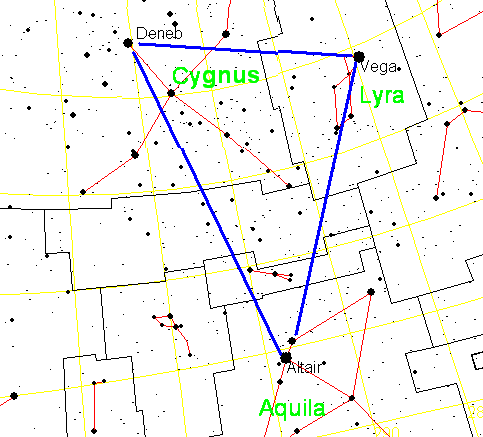The Summer Triangle is a popularly known pattern or group of stars that can be seen in the night sky in the northern celestial hemisphere to help astronomers find other objects in the sky. The defining vertices of this imaginary triangle can be found at the stars Altair, Deneb, and Vega, each of which is the brightest star of its constellation. The star Deneb is in the constellation Cygnus the Swan, Vega in the constellation Lyra the Harp, and Altair in the constellation Aquila the Eagle.
Although it was popularized by American author H. A. Rey and British astronomer Patrick Moore in the 1950s; the term “Summer Triangle” can be found in constellation guidebooks as far back as 1913. At that time, an Austrian astronomer named Oswald Thomas described these stars as Grosses Dreieck, which means Great Triangle, in the 1920s and described these stars as Sommerliches Dreieck, Summerly Triangle, in 1934.
These stars have been grouped together before, as Joseph Johann von Littrow described the triangle in his 1866 atlas, and Johann Elert Bode connected the stars in a map in a 1816 book. These stars have been grouped together even further back in time with the Chinese legend of The Cowherd and the Weaver Girl, which dates back about 2,600 years. In the aviation world, in the mid- to late 20th century before military planes had inertial navigation systems and other fancy equipment, it would be common for some navigators to refer to the Summer Triangle as the “Navigator’s Triangle”.
From the Pacific Northwest, the Summer Triangle appears virtually overhead around midnight during entire summer observing period. During the spring observing periods, the Summer Triangle is visible in the eastern sky in early mornings. During the autumn and winter evenings, the Triangle is visible in the western sky until January. It is worth noting that for mid-southern observing, the stars that make up the triangle are inverted.
Observing the Summer Triangle at nightfall in northern summer can be done by looking for the brightest star in the eastern sky, which is Vega. Then looking to the left if Vega should show another bright star named Deneb. Deneb is the least bright of all the Summer Triangle stars. Typically, the distance from Vega to Deneb can be described as equal to an outstretched hand at arm’s length. To find Altair, one would need to return to Vega and look to the lower right, which is said to be a ruler at arms length distance from Vega.

Leave a comment